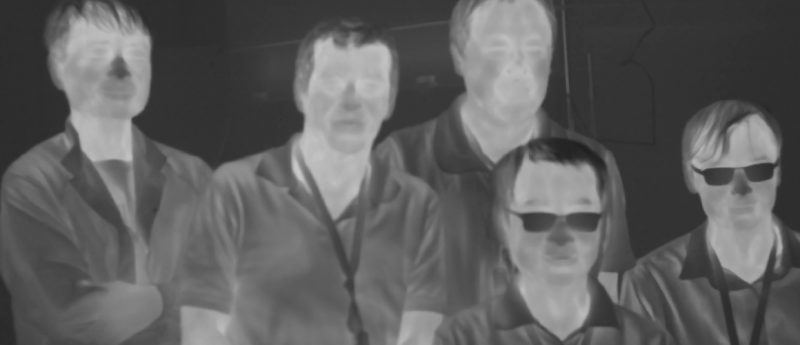
Infrared Cameras WIRED to Require Less Cooling

HRL Laboratories’ WIRED team L to R: Shuoqin Wang, Sevag Terterian, Brett Nosho, Minh Nguyen, and Alex Gurga. © 2019 HRL Laboratories.
HRL Laboratories Wafer-Scale Infrared Focal Plane Arrays Will Run at Higher Temperatures to Reduce Cooling and Cost of IR Cameras
HRL Laboratories, LLC, is completing development of wafer-scale infrared focal plane arrays (FPAs) that will dramatically reduce the size and cost of infrared (IR) cameras. HRL was selected to carry on Phase III of the Defense Advanced Research Project Agency (DARPA)’s program Wafer-scale Infrared Detectors or WIRED.
The resulting low-cost compact IR cameras will be more accessible to consumers
WIRED Phase III has two main goals. The first is to mature wafer-scale fabrication of FPAs, making them very low cost, high-yield technology that can be widely manufactured. The second is to reduce the high cost of cooling infrared cameras by leveraging advances in detector and read-out integrated circuit designs to build devices that perform at higher temperatures.
“The current industry practice is to process FPAs in series,” said HRL’s WIRED principal investigator Minh Nguyen. “That means that we might have several different IR detector array chips fabricated on one wafer that are then diced apart into individuals. Each chip has to be hybridized and integrated with a Silicon read out integrated circuit chip to build one complete FPA. The process is repeated for each FPA, which is very time consuming and expensive. Furthermore, to work properly, each camera needs a bulky cooling apparatus that can keep the circuit very cold, around 77 to 120 Kelvin. These factors combine to make infrared cameras very costly.”
HRL’s approach is to process the entire integrated circuit with all its elements already combined on a wafer. This is a challenge because it requires mating two wafer materials—one silicon for readout circuitry, the other a III-V light sensing material—that do not combine easily at full wafer-scale. With the WIRED fabrication technique, the cost of each FPA is dramatically reduced.
“In Phases I and II we showed that our concept is feasible,” Nguyen said. “Now we are working to make the technique practical on a large-size (up to 6-inch diameter), multiple-wafer fabrication scale. At the same time, we are implementing a new read-out integrated circuit that enables the FPAs to operate at up to 230 Kelvin. This much warmer operating temperature allows another major cost savings because FPAs that operate at this temperature can be cooled by smaller, less expensive thermoelectric coolers instead of the bulky and expensive cryo-coolers currently used. The resulting low-cost compact IR cameras will be more accessible to consumers.”
Thermal IR cameras use an imaging mode that is completely different from typical visible-light cameras. While visible-light cameras require a source of illumination, for example the sun or lights, thermal IR cameras can image an object from its infrared signature and do not require additional lighting. They also have better penetration through fog, smoke, and certain other media, and can reveal the temperature of objects. IR cameras enable secure surveillance without a light source.
This material is based upon research supported by the United States Air Force under Contract No. FA8650-16-C-7636 and with funding from the Defense Advanced Research Projects Agency (DARPA). Any views, opinions, findings, conclusions, or recommendations expressed in this material are those of the author(s) and do not necessarily reflect the views of the United States Air Force nor should they be interpreted as representing the official views or policies of the Department of Defense or the U.S. Government.
HRL Laboratories, LLC, California (hrl.com) pioneers the next frontiers of physical and information science. Delivering transformative technologies in automotive,aerospace and defense, HRL advances the critical missions of its customers. As a private company owned jointly by Boeing and GM, HRL is a source of innovations that advance the state of the art in profound and far-reaching ways.
Media Inquiries: media[at]hrl.com, (310) 317-5000